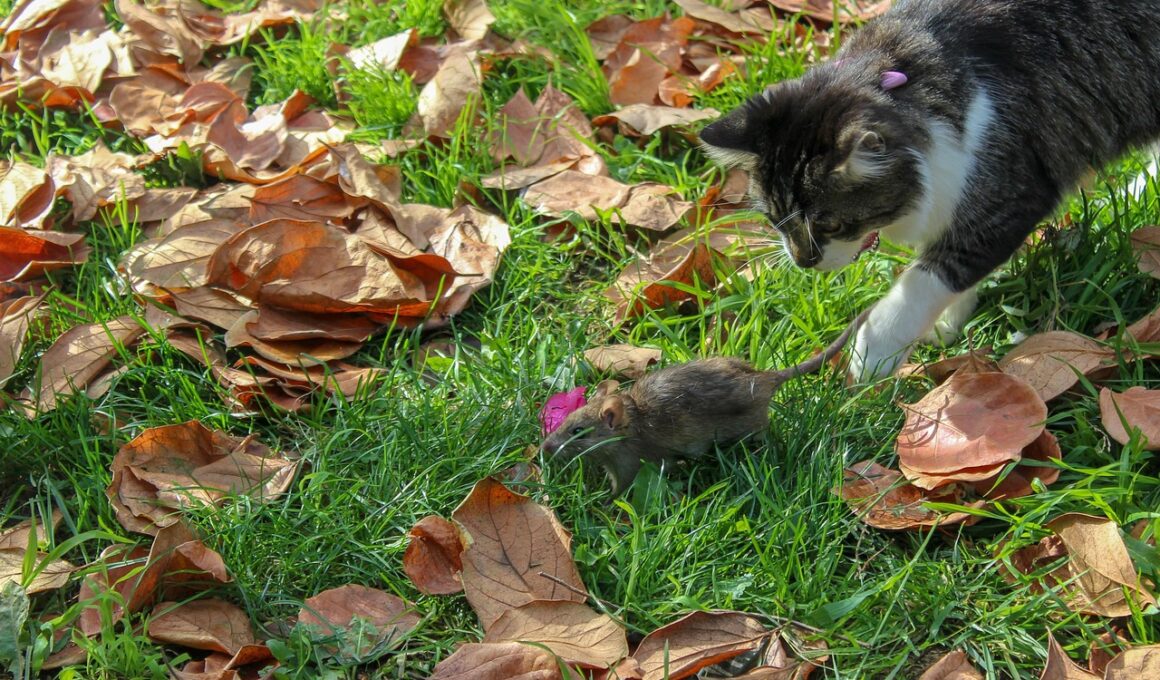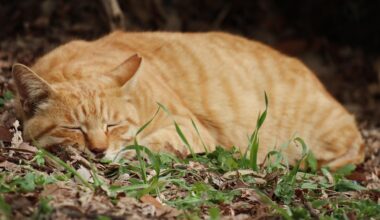Understanding Tail Chasing Behavior
Tail chasing in cats is a peculiar behavior that often baffles pet owners. Many view it as an amusing quirk, while others worry that it may indicate underlying problems. Understanding the motivations behind this behavior is crucial for effective management. Cats may chase their tails for various reasons, including boredom, stress, or even physical issues like fleas. Enrichment activities can help alleviate tail chasing by providing mental stimulation and alternatives to this repetitive motion. Enrichment can reduce anxiety and stress, which often trigger this behavior. Creating an engaging environment allows cats to channel their energy into more constructive activities. Moreover, observing your cat closely can help identify triggers, facilitating better management. It’s essential for owners to balance play and quiet time, ensuring the cat feels safe and engaged. Engaging in regular interactive play can keep a cat’s interest away from its tail. Always consult a veterinarian if the behavior persists, ensuring there are no medical issues involved. Educating oneself about feline behavior helps foster a better relationship with your pet, ultimately improving its quality of life. Taking proactive measures can minimize tail chasing and enhance your cat’s well-being.
Enrichment Activities You Can Implement
Implementing enrichment activities in your cat’s daily routine is vital for curbing tail chasing. A wide range of options exists to engage your feline friend, stimulating both their mind and body. One effective method is introducing puzzle feeders that require cats to work for their food. These devices challenge their problem-solving skills and distract from tail-related behavior. Additionally, creating a designated play area filled with various toys, tunnels, and cat trees can help redirect their focus. Engage in daily interactive play sessions using feather wands or laser pointers, which provide an outlet for their natural hunting instincts. Cats thrive on unpredictability, so regularly rotating their toys can keep them intrigued and active. Consider incorporating outdoor time in a secure environment, such as a catio, allowing for exploration while ensuring safety. Sound stimulation, like cat TV or bird feeders visible from a window, can also pique their interest. Moreover, offering scratching posts or climbing shelves allows cats to express natural behaviors, steering away from tail chasing. Remember, consistency is key in maintaining a stimulating environment for your cat, helping them remain balanced and content.
Recognizing Stressors in Cats
Recognizing stressors in cats is essential for addressing tail chasing behavior effectively. Various factors can contribute to anxiety in felines, leading them to chase their tails. Changes in the household environment, such as moving to a new home or introducing new pets, can create stress. Loud noises, such as thunderstorms or fireworks, can also provoke anxiety. Observing your cat for signs of stress is vital; behaviors like hiding, excessive grooming, or loss of appetite can indicate that your cat is overwhelmed. Providing a safe space where your cat feels secure can significantly reduce anxiety levels. Creating vertical spaces for them to retreat to, such as shelves or cat trees, can foster a sense of safety. Additionally, employing calming products such as pheromone diffusers can help soothe anxious cats. Providing a consistent daily routine can also minimize stress by ensuring predictability in their lives. Offering opportunities for play, along with time for relaxation, balances their emotional needs. Regular veterinary check-ups can help rule out medical issues contributing to their stress, allowing for a focused approach to managing tail chasing.
Utilizing Positive Reinforcement Techniques
Using positive reinforcement techniques can significantly alter behavior patterns in cats prone to tail chasing. When a cat exhibits desirable behavior, rewarding them with treats or affection can encourage them to engage in positive activities instead. For example, if your cat plays with a toy instead of chasing its tail, offer praise and rewards to reinforce that action. Gradually, your cat will learn to associate positive outcomes with productive behaviors, steering away from unnecessary tail chasing. Consistency is vital in implementing this method; owners must ensure that they reward their cat every time they choose the appropriate behavior. Furthermore, ensure that the rewards are enticing enough to grab their attention. Gradually reduce the frequency of treats as the behavior becomes ingrained, helping establish long-term habits. Creating various scenarios for play can also increase engagement, making cats less likely to focus on their tails. Incorporating training sessions alongside playtime can provide both mental stimulation and reinforce desirable behaviors. Engaging multiple senses during these sessions can capture the cat’s interest, offering an effective detour from unwanted behaviors.
Creating a Multi-Dimensional Space
Designing a multi-dimensional space can greatly benefit cats prone to tail chasing. Cats need a stimulating environment to express their natural instincts, reducing the likelihood of engaging in repetitive behaviors. A well-structured space begins with vertical surfaces, such as shelves or cat trees, allowing cats to climb and survey their territory. Additionally, incorporating diverse textures through scratching posts helps fulfill their need to scratch and ensures satisfaction. Various hiding spots, such as tunnel-like structures or cardboard boxes, can also provide an element of surprise, capturing their curiosity. Moreover, interactive toys that mimic hunting behaviors, like feather or wand toys, allow cats to engage their predatory skills. Including natural elements, like climbing plants or cat grass, can intrigue their senses and promote exploration. Creating a safe outdoor experience through a catio can also enhance their overall well-being. Ensure that all areas are accessible, considering the cat’s age and ability. Continuously assessing and adjusting the environment as your cat grows is essential. Ultimately, a multi-dimensional living space encourages natural behavior, significantly minimizing unwanted habits like tail chasing.
Evaluating Behavioral Changes Over Time
Evaluating behavioral changes over time is crucial to understanding whether your cat’s tail chasing behavior is improving. Regularly monitoring your cat’s activities allows you to identify patterns, triggers, and improvements. Keeping a journal detailing daily observations can provide insights into their behavior, helping discern which enrichment activities work effectively. Look for positive changes, such as reduced frequency of tail chasing or increased engagement with toys and play. Also, note any stressors or situations that may trigger tail chasing to address them proactively. Behavioral assessments can be enhanced through consultation with a veterinarian or animal behaviorist. They can provide deeper insights into your cat’s behavior and recommend tailored strategies that align with identified problems. It’s essential to be patient during this process; behavioral modifications take time, and every cat is unique. Simple lifestyle changes, such as increasing playtime, can significantly affect their overall disposition. By evaluating these changes consistently, you can reinforce positive behaviors, ensuring the long-term improvement of your cat’s well-being. Ultimately, a practical, informed approach leads to effective management of tail chasing behavior.
Conclusion and Ongoing Commitment
In conclusion, managing tail chasing behavior in cats requires an ongoing commitment to providing an enriching environment. Tail chasing is more than a quirky behavior; it often indicates underlying stress or boredom. Implementing various enrichment activities, recognizing stressors, and utilizing positive reinforcement techniques can aid in curtailing this behavior effectively. Moreover, creating a multi-dimensional living space and evaluating behavioral changes over time allows cat owners to take proactive measures. Focusing on your cat’s well-being fosters a deeper bond while ensuring happiness. Each cat is unique, requiring personalized strategies based on their preferences and needs. Therefore, flexibility in adapting methods based on your observations can provide better outcomes. Consistent commitment to engaging activities ensures your cat remains mentally stimulated and healthy. Collaborating with professional guidance can enhance your understanding of feline behavior, supporting your journey in managing tail chasing. Always prioritize your cat’s physical and emotional health, fostering harmony in the relationship. By adopting a holistic approach, you can significantly improve your cat’s quality of life, leading to a more content and stable state. Tail chasing does not have to be an issue, and with dedication, it can be transformed into an improved feline experience.


